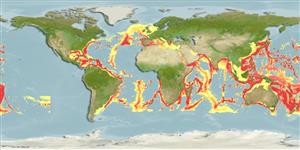Common names from other countries
Classification / Names / Names
Nomi Comuni | Sinonimi | Catalog of Fishes (gen., sp.) | ITIS | CoL | WoRMS
Environment: milieu / climate zone / depth range / distribution range
Ecologia
; distribuzione batimetrica 0 - 3700 m (Ref. 356). Tropical
Circumglobal.
Length at first maturity / Size / Peso / Age
Maturity: Lm ? range ? - ? cm Max length : 7.5 cm WD maschio/sesso non determinato; (Ref. 3719)
Littoral to sublittoral (Ref. 99821). Intertidal (Ref. 106854), in highly exposed shores (Ref. 125338). Known as a fouling species (Ref. 81749).
Life cycle and mating behavior
Maturità | Riproduzione | Deposizione | Uova | Fecundity | Larve
Members of the superorder Thoracica are mostly hermaphroditic. Broadcast spawners, fertilization occurs in the mantle cavity. Life cycle: Eggs hatch into planktonic nauplii and leave the mantle cavity. Afterwards, they undergo six naupliar instars succeded by nonfeeding cypris larva (settling stage) which later metamorphose into adults.
Young, P.S. 1998. (Ref. 3549)
IUCN Red List Status (Ref. 130435)
CITES status (Ref. 108899)
Not Evaluated
Not Evaluated
Human uses
Pesca: commerciale
| FishSource | Sea Around Us
Strumenti
Informazioni ulteriori
Age/Size
Accrescimento
Length-weight
Length-length
Morfologia
Larve
Abbondanza
Fonti Internet
Estimates based on models
Preferred temperature
(Ref.
115969): 3.1 - 11.4, mean 5.1 (based on 2256 cells).
Vulnerability
Low vulnerability (10 of 100).
Price category
Unknown.
